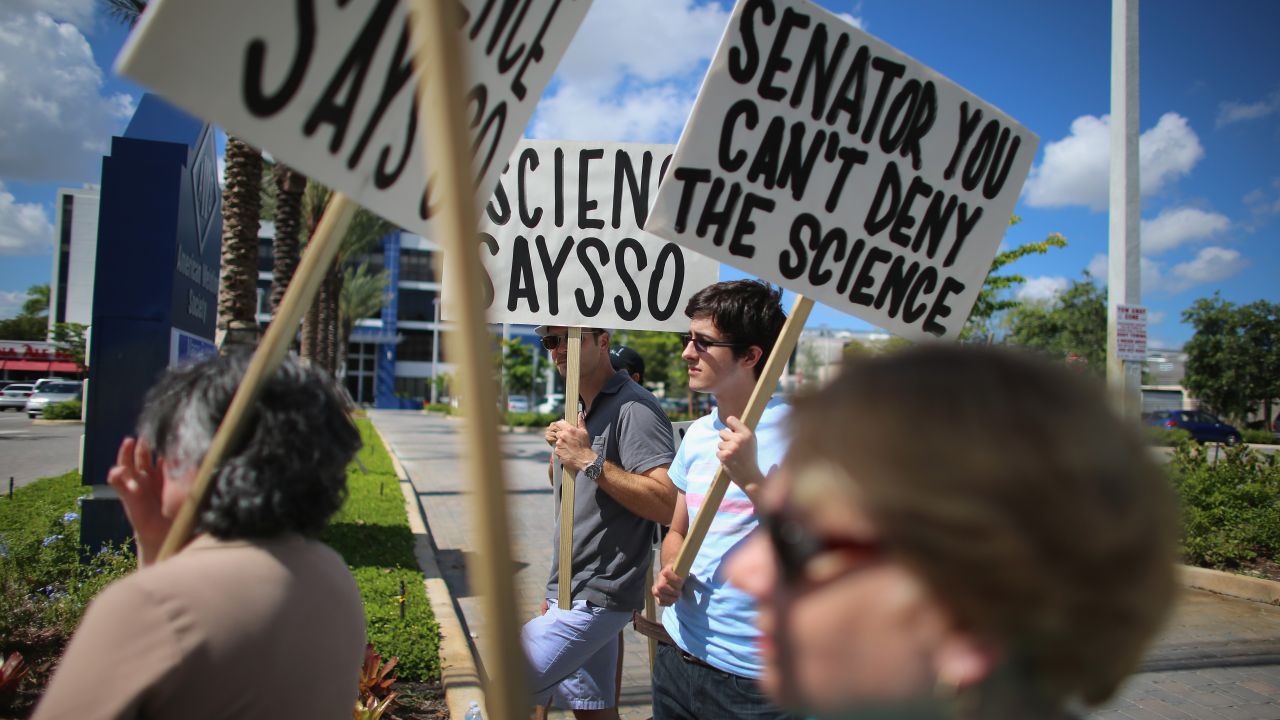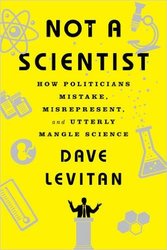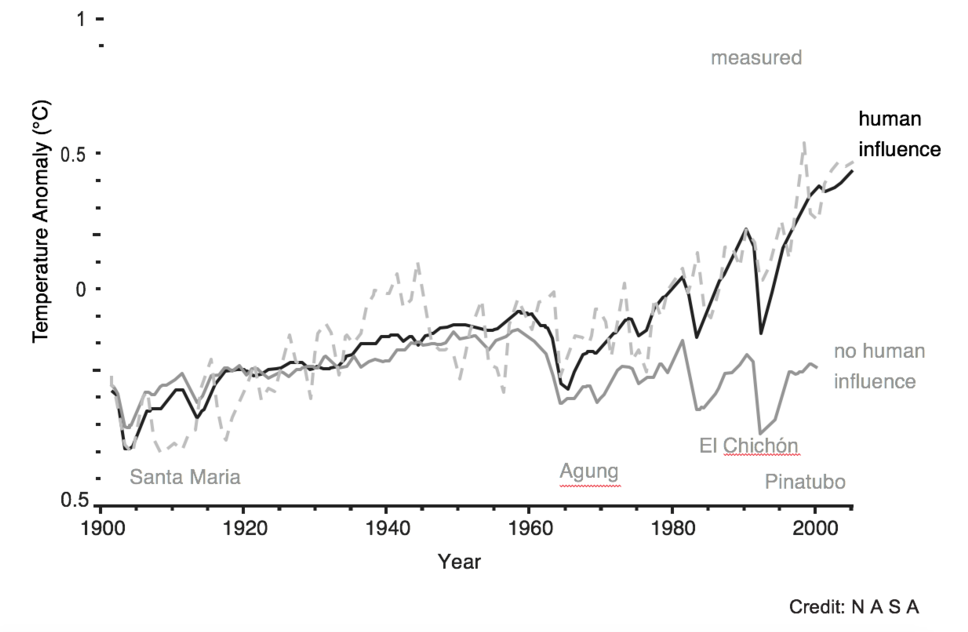
Protesters gather near the office of US Sen. Marco Rubio (R-FL) to ask him to take action to address climate change in August 2013. (Photo by Joe Raedle/Getty Images)
Excerpt from Not a Scientist: How Politicians Mistake, Misrepresent, and Utterly Mangle Science by Dave Levitan. Copyright © 2017 by Dave Levitan. Reprinted with permission of W.W. Norton & Company, Inc. All rights reserved.

Not a Scientist
The CERTAIN UNCERTAINTY is a tactic where politicians hype the unknowns, or the margin of error inherent to every measurement ever taken, in order to disguise just how much we really do know. In short, they claim that since we don’t know it all, we don’t know anything.
Politicians deploy the certain uncertainty on several specific climate-related topics. Climate science is a broad and complicated field, so there are many specific topics on which one can claim a lack of proof. For a first example, let’s look at what Jeb Bush had to say in 2015:
I don’t think the science is clear of what percentage is man-made and what percentage is natural. I just don’t — it’s convoluted. And for the people to say the science is decided on this is just really arrogant, to be honest with you.1
We’ll ignore the fact that doubting what the entirety of the world’s scientists say on an issue seems a tad more arrogant than those scientists explaining what is known. Focus on the message here: the science is not “clear” as to humanity’s contribution to warming; the science is “convoluted.” By casting doubt on what we know, Bush argued essentially that we know nothing. He was, of course, wrong.
Science does, in fact, have a good idea of how much of the observed warming is due to human impacts. Spoiler: pretty much all of it.
Here’s how the Fifth Assessment Report of the Intergovernmental Panel on Climate Change (IPCC) summarized this question in 2013:
It is extremely likely that human activities caused more than half of the observed increase in [global mean surface temperature] from 1951 to 2010. 2
The report added that this conclusion is “supported by robust evidence from multiple studies using different methods.” In other words, we are really sure about this, and there is a lot of evidence for it.
A primary method scientists have for determining what caused a certain climatic phenomenon — in this case, warming temperatures — is called a fingerprint analysis, or fingerprint study. Basically, the idea is to look for the unique mark of certain activities on the climate system — an imprint of humans placed on the world. Scientists do this by comparing what we observe to what the computer models would predict.
Models are complicated computer simulations that try to replicate what goes on in the climate. There are many of these in use by scientists around the world. By allowing researchers to add and subtract elements in their predictions, the models make fingerprinting possible. For example, a model might begin from near the start of the Industrial Revolution (say, around the year 1800) and run through the present day. In one scenario, the model simulates what happens to the climate when humans emit all the carbon dioxide that we really have emitted since then; in another, it simulates the same time period but without the CO2 emissions.
What these studies show is that when you remove human influence from the equation, all the warming we have observed in the real world disappears. No humans, no warming. Here’s a chart from NASA3 illustrating this idea:
The lines representing modeled human influence and observations match up extremely well, while the “no human influence” line stays largely flat and even shows a cooling trend (the chart notes some major volcanic eruptions, which have a cooling effect on global temperatures).
The models don’t just look at human CO2 emissions. They include a wide variety of inputs, such as other emissions, like sulfate aerosols (which have a cooling effect, though a brief one), and nonhuman activities like volcanic eruptions and solar activity. And study after study, of a variety of types, have all pointed to humans as the primary cause of the significant warming observed.
The IPCC has tried to estimate specific temperature changes that can be attributed to various of these causes: human greenhouse gas emissions, solar activity and so on.4 Their answer, in short: Humans have caused all the warming we have seen, while natural variability and other causes, such as solar output, account for essentially none of it.
These conclusions, as the IPCC noted, come from a wide variety of sources. Here are just a couple of them: One study, published in the journal Climate Dynamics in 2012, used a statistical method to assess the various contributions to warming. The authors concluded: “The expected warming due to all human influences since 1950… is very similar to the observed warming.”5 Another, published in Nature Geoscience in 2011, combined multiple models to ask similar questions and found that it is “extremely unlikely” that the observed warming could be caused by internal variability — that is, by nonhuman influence.6
Again: The world has warmed, and we did it. It’s us, and essentially nothing else. Yet many politicians continue to parrot the same general message: We don’t know how much the world is actually warming, and we don’t know how much warming is due to human activity; therefore, let’s not do anything about it. The last part of that argument, that we should do nothing at all, is its own type of the certain uncertainty. Here’s Florida senator and 2016 presidential candidate Marco Rubio, appearing on Face the Nation in April 2015:
I believe the climate is changing because there’s never been a moment where the climate is not changing. The question is, what percentage of that… is due to human activity? If we do the things they want us to do, cap-and-trade, you name it, how much will that change the pace of climate change versus how much will that cost to our economy? Scientists can’t tell us what impact it would have on reversing these changes, but I can tell you with certainty, it would have a devastating impact on our economy.7
Rubio repeated that same tired refrain, that the human contribution is somehow unknown and unknowable. Then he offered up a particularly brazen version of the certain uncertainty: he claimed that scientists “can’t tell us” what would happen if we actually tried to slow warming and said “with certainty” that taking any actions to mitigate climate change — “cap-and-trade, you name it” — would have a terrible effect on the economy.
Rubio’s claim that indeed it is certain that taking action would destroy the economy bears scrutiny. This is, obviously, more of an economic discussion than a scientific one, but of course understanding the economic effects of climate change requires an understanding of science. And the experts that have actually undertaken this sort of analysis are clear: doing nothing will cost far more than doing something.
The most cited and perhaps most comprehensive analysis of the economics of climate change is now a decade old. The 700-page “Stern Review,”8 conducted by UK economist Nicholas Stern and released in 2006, had a stark and firm conclusion: keeping global warming to a reasonable level — 1.5°C — would cost money, and a lot of it. In fact, it would cost about 1 percent of the entire world’s GDP annually by 2050. But without such actions? The costs would be absolutely devastating, falling somewhere between 5 percent and 20 percent of global GDP each year.
Other studies have also found huge costs associated with inaction, and surprisingly low costs associated with action. A group at Stanford University led by Mark Z. Jacobson, modeling scenarios in which every state in the United States could transition to 100 percent renewable energy by 2050, has found that such a world would actually cost substantially less than just continuing on our current, fossil fuel–heavy path.9 Jacobson has said that “when you account for the health and climate costs — as well as the rising price of fossil fuels — wind, water and solar are half the cost of conventional systems. A conversion of this scale would also create jobs, stabilize fuel prices, reduce pollution-related health problems and eliminate emissions from the United States. There is very little downside to a conversion, at least based on this science.”10
A study published in Nature in 2015 found that not engaging in such a conversion would have a remarkable effect: a decline in global incomes by 23 percent by 2100.11 One of the study authors, Marshall Burke, also of Stanford, said: “We’re basically throwing money away by not addressing the issue.”12
Virtually every proposed climate-related policy in the United States is met with that same refrain: that it will destroy the economy. When Rubio made his comments, the primary policy bogeyman was the Clean Power Plan, an Obama- and EPA-led regulation designed to reduce emissions from power plants. Opponents of the regulation, which would have the effect of shuttering some coal-fired power plants and making it nearly impossible to build new ones, claim that the costs would be prohibitive. Indeed, some not-very-independent reports found just such problems. A consulting firm called National Economic Research Associates released a report in late 2014 that found a total increase in energy costs of $479 billion over the period from 2017 through 2031.13 Half a trillion dollars!
There are a lot of problems with this report. The most basic appears on the first page, which lists the groups for whom the report was prepared. The list includes the National Mining Association, the American Coalition for Clean Coal Electricity, American Fuel & Petrochemical Manufacturers and others with more than a little bit of skin in the game. More fundamentally, the analysis ignores a wide variety of factors such as energy efficiency improvements and incentive programs for low-income communities, and it offers very little information about how exactly it arrived at its cost estimates.14
If you ask the EPA itself — which, of course, has biases of its own — the benefits of the Clean Power Plan far outweigh the costs.15 The costs here are technology costs: building new energy infrastructure, retrofitting older plants to reduce emissions and so on. The benefits are many; for example, by reducing the number of coal plants, a whole host of public health benefits emerge. Along with CO2, those plants emit other harmful pollutants, such as PM2.5, tiny particles that exacerbate asthma, cause other respiratory illnesses and result in thousands of premature deaths every year. Those outcomes have associated costs, many of which have been quantified.
There are direct climate-related benefits as well, of course; by reducing CO2 emissions, we slow climate change, meaning we slow sea-level rise, reduce the impacts of stronger storms and lengthier droughts, and so on. These things add up! And perhaps the biggest benefit, though easily the hardest to quantify, is the issue of leadership. The United States was the biggest CO2 emitter for many decades, and it remains second only to China; A global agreement to slow climate change requires American — and Chinese and Indian and Brazilian and other countries’ leadership. If the United States couldn’t even take modest steps to reduce its own emissions, how could it argue for the rest of the world to take such steps? The Clean Power Plan gave the United States a strong leadership position on the issue, a position that arguably helped bring about the international agreement signed in 2015 by 195 countries that will hopefully put the world on a path toward slowing warming.
In the end, the EPA estimated that the net benefits — including the technological costs of updating some infrastructure — would come to somewhere between $26 and $45 billion annually by 2030. Put another way, the EPA calculated a dollar number similar to that estimated by NERA, but in the exact opposite direction, with a benefit instead of a cost. The two sides were, incredibly, a trillion dollars apart in their analyses.
Even CitiGroup (which now goes by just “Citi”), not usually considered an environmental champion, has stated clearly that letting climate change happen is a lot worse economically than the alternative. Citi released a study estimating that an “action scenario” would cost about $190.2 trillion over 25 years — a hefty price tag.16 But wait! The “inaction scenario,” in which we do nothing but continue burning fossil fuels and continue on our current path, would cost $192 trillion; and that’s before the damages due to a warming world are even factored in. Allowing the planet to warm 2.5°C, Citi said, would shave $44 trillion off the global GDP. Letting the increase in temperature go all the way to 4.5°C, which is feasible if we don’t stop emitting soon, would cost $72 trillion. That’s more than four times the current US GDP, and only $5 trillion less than the entire world’s GDP in 2014.
The point is this: Rubio claimed that the economic hardships associated with reducing emissions are written in stone. In actuality, they are — but they are opposite from what the senator said. There is near-universal agreement at this point — except among the industries fighting to stay relevant in a changing world, like coal and oil — that acting strongly to mitigate climate change would have a positive economic effect. Rubio’s certain uncertainty leans on the idea that taking action requires a leap into some big black hole of unknowns. In actuality, the science itself is far more certain than uncertain, and the economic impacts don’t even vaguely resemble his assurances.
1. C. Dann, “Jeb Bush Blasts ‘Intellectual Arrogance’ in Climate Change Debate,” NBC News, May 21, 2015, ↩
2. N. L. Bindoff, K. M. AchutaRao, M. R. Allen, et al., “Detection and Attribution of Climate Change: From Global to Regional,” in Climate Change 2013: The Physical Science Basis. Contribution of Working Group I to the Fifth Assessment Report of the Intergovernmental Panel on Climate Change, ed. T. F. Stocker, D. Qin, G.-K. Plattner, et al. (Cambridge University Press, 2013), 887. ↩
3. R. Lindsey, “If Earth Has Warmed and Cooled throughout History, What Makes Scientists Think That Humans Are Causing Global Warming Now?” Earth Observatory (blog), NASA, May 4, 2010 ↩
4. Bindoff et al., “Detection and Attribution of Climate Change,” 884 (fig. 10.5). ↩
5. T. M. L. Wigley and B. D. Santer, “A Probabilistic Quantification of the Anthropogenic Component of Twentieth Century Global Warming,” Climate Dynamics 40 (2012): 1087–1102. ↩
6. M. Huber and R. Knutt, “Anthropogenic and Natural Warming Inferred from Changes in Earth’s Energy Balance,” Nature Geoscience 5 (2012): 31–36. ↩
7. Marco Rubio, on Face the Nation: “Face the Nation Transcripts,April 19, 2015: Rubio, Manchin, O’Malley,” CBS News. ↩
8. N. Stern, “Stern Review: The Economics of Climate Change: Executive Summary.” ↩
9. M. Z. Jacobson, M. A. Delucchi, M. A. Cameron, et al., “Low-Cost Solution to the Grid Reliability Problem with 100% Penetration of Intermittent Wind, Water, and Solar for All Purposes,” Proceedings of the National Academy of Sciences 112 (2015): 15060–65. ↩
10. B. Carey, “Stanford Engineers Develop State-by-State Planto Convert US to 100% Clean, Renewable Energy by 2050,” Stanford News Service, June 8, 2015.↩
11. M. Burke, S. M. Hsiang, and E. Miguel, “Global Non-linearEffect of Temperature on Economic Production,” Nature 527 (2015): 235– 39. ↩
12. J. Worland, “Climate Change Could Wreck the Global Economy,” TIME, Oct. 22, 2015. ↩
13. National Economic Research Associates, “Potential Energy Impactsof the EPA Proposed Clean Power Plan,” Oct. 17, 2014. ↩
14. J. Rogers, “ACCCE, NERA, and Another Misleading Studyabout the Clean Power Plan,” The Equation (blog), Union of Concerned Scientists, Nov. 12, 2015. ↩
15. Environmental Protection Agency, “Regulatory Impact Analysisfor the Clean Power Plan Final Rule” ↩
16. Citi, “Energy Darwinism II: Why a Low Carbon Future Doesn’t Have to Cost the Earth,” August 2015. ↩





